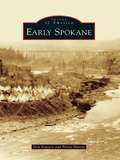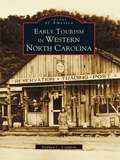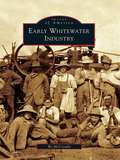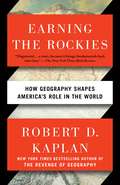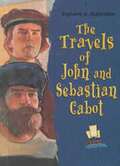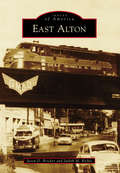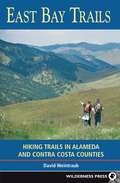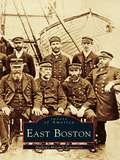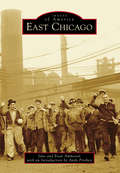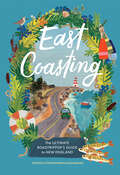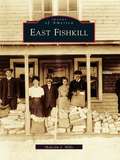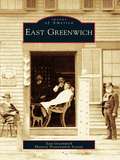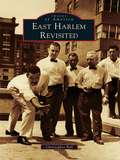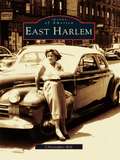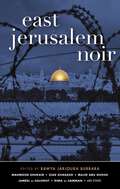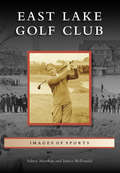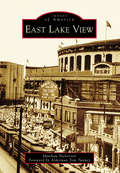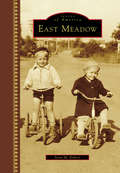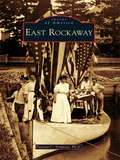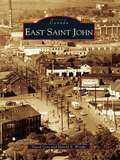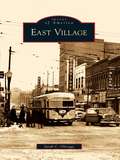- Table View
- List View
Early Spokane
by Penny Hutten Don PopejoySpokan Falls, known as the "Capital of the Inland Empire," was named after the Spokan Indians and the picturesque falls. In 1891, the name was changed to Spokane. The town thrived as a result of the abundant waters of the Spokane River, which powered saw and grain mills, and lured major transcontinental railways to Spokane in 1881. In 1889, a fire destroyed the downtown area, but like a forest after a fire, the town enjoyed growth and resurgence soon after. Spokane would attract people as diverse as Pres. Theodore Roosevelt, Calamity Jane, Billy Sunday, and Charles Lindbergh. Easterners found that its four seasons and profusion of scenic city parks gave them a place to ensure their destiny.
Early Tourism in Western North Carolina
by Stephen C. ComptonAt the beginning of the 20th century, many Americans moved from farm to town, changing from agricultural employment to jobs in factories and retail shops. Along with these new occupations came a new idea called "vacation." Ready access to automobiles made leisure travel, once reserved for affluent citizens, increasingly feasible and affordable for working class people. With its cool climate and outstanding scenery, the mountain region of North Carolina became a welcome refuge and ideal tourist destination for weary workers and their families. Western North Carolina, often touted in promotional materials as the "land of the sky," hosts Mount Mitchell-the highest mountain east of the Mississippi River-hundreds of waterfalls, some of the world's oldest mountains and rivers, and abundant wildlife. The well-known Blue Ridge Parkway, numerous inns, lodges, hotels, campgrounds, and restaurants were constructed to serve the region's growing number of visitors.Early Tourism in Western North Carolina celebrates the rise of tourism from 1900 to 1950 in the Blue Ridge and Appalachian mountains of North Carolina. Sites featured include the Great Smoky Mountains National Park, the Blue Ridge Parkway, Grandfather Mountain, Blowing Rock, Asheville, Mount Mitchell, Chimney Rock, the Biltmore Estate, and the Cherokee Indian Reservation.
Early Whitewater Industry
by Bo MccreadyAfter the arrival of the Milwaukee and Mississippi Railroad in 1852, Whitewater became a regional shipping center that blossomed into a powerful industrial town. The Esterly Harvesting Machine Company and the Winchester and Partridge Wagon Works established their first factories in Whitewater after the coming of the Milwaukee and Mississippi. Their manufactured goods were known around the country for exceptional quality. A myriad of new inventions and patents came from Whitewater's business population, and Whitewater's farmers and dairymen consistently won prizes for their produce, while its factories produced reapers and wagons that won national competitions. In the 1890s, however, development suddenly stopped and Whitewater lost its economic clout in a few short years. This book explains what happened to Whitewater.
Earning the Rockies: How Geography Shapes America's Role in the World
by Robert D. KaplanAn incisive portrait of the American landscape that shows how geography continues to determine America’s role in the world—from the bestselling author of The Revenge of Geography and Balkan GhostsAs a boy, Robert D. Kaplan listened to his truck-driver father tell evocative stories about traveling across America in his youth, travels in which he learned to understand the country literally from the ground up. There was a specific phrase from Kaplan’s childhood that captured this perspective: A westward traveler must “earn the Rockies” by driving—not flying—across the flat Midwest and Great Plains. In Earning the Rockies, Kaplan undertakes his own cross-country journey to recapture an appreciation of American geography often lost in the jet age. Traveling west, in the same direction as the pioneers, Kaplan traverses a rich and varied landscape that remains the primary source of American power. Along the way, he witnesses both prosperity and decline—increasingly cosmopolitan cities that thrive on globalization, impoverished towns denuded by the loss of manufacturing—and paints a bracingly clear picture of America today. The history of westward expansion is examined here in a new light—as a story not just of genocide and individualism, but also of communalism and a respect for the limits of a water-starved terrain, a frontier experience that bent our national character toward pragmatism. Kaplan shows how the great midcentury works of geography and geopolitics by Bernard DeVoto, Walter Prescott Webb, and Wallace Stegner are more relevant today than ever before. Concluding his journey at Naval Base San Diego, Kaplan looks out across the Pacific Ocean to the next frontier: China, India, and the emerging nations of Asia. And in the final chapter, he provides a gripping description of an anarchic world and explains why America’s foreign policy response ought to be rooted in its own geographical situation. In this short, intense meditation on the American landscape, Robert D. Kaplan reminds us of an overlooked source of American strength: the fact that we are a nation, empire, and continent all at once. Earning the Rockies is an urgent reminder of how a nation’s geography still foreshadows its future, and how we must reexamine our own landscape in order to confront the challenges that lie before us. Advance praise for Earning the Rockies“A text both evocative and provocative for readers who like to think . . . In his final sections, Kaplan discusses in scholarly but accessible detail the significant role that America has played and must play in this shuddering world.”—Kirkus Reviews“Earning the Rockies is a brilliant reminder of the impact of America’s geography on its strategy. An essential complement to his previous work on the subject of geostrategy, Kaplan’s latest contribution should be required reading.”—Henry A. Kissinger “Robert D. Kaplan uses America’s unique geography and frontier experience to provide a lens-changing vision of America’s role in the world, one that will capture your imagination. Unflinchingly honest, this refreshing approach shows how ideas from outside Washington, D.C., will balance America’s idealism and pragmatism in dealing with a changed world. A jewel of a book, Earning the Rockies lights the path ahead.”—General (Ret.) James Mattis
Earth's Explorers: John And Sebastian Cabot
by Joanne MatternLong-ago adventures are still a thrill in these vividly illustrated titles. These exciting tales of the quest for wealth and land describe the routes taken by famous explorers, the hardships they endured, and the rewards they reaped. Titles also address the impact these explorations made on the native inhabitants of conquered lands.
East Africa Handbook: With Kenya, Tanzania, Uganda and Ethiopia (4th edition)
by Mike HoddThis updated handbook of detailed, practical information on East Africa, covers all the 10 countries in the region. These include: the three great safarilands of Kenya, Tanzania and Uganda; the countries of the central mountains, Rwanda, Burundi and Eastern Zaire; and the nations of the horn of Africa - Ethiopia, Eritrea, Somalia and Djibouti.
East Alton (Images of America)
by Jason D. Bricker Judith M. RichieEast Alton has a long and proud history. From the earliest settlement, Beeman’s (Benen) Fort, in 1811, the village of East Alton has long been an industrial powerhouse. The home of Olin Corporation’s Winchester Division, East Alton’s industrial production played an important part in winning both world wars. East Alton shared a synergistic growth with Olin Corporation. Having all the trappings of a company town, it somehow transcended this to become a thriving diverse community, filled with a dedicated citizenry, strong schools, generous communities of faith, and a guiding government. East Alton’s incorporation in 1893 was just four years before this country’s first economic depression, the Depression of 1897. Overcoming economic challenges and fostering growth has enabled the village not only to survive but also to succeed.
East Bay Trails
by David WeintraubThe only guide dedicated entirely to hiking San Francisco's East Bay has been revised and updated, and features 3 new trips in Contra Costa County. Includes 56 trips for hiking, bicycling, and horseback riding on oak-studded hills, grassy ridges, rocky peaks, forested valleys, and salt-marsh shoreline. East Bay Trails is the most complete and up-to-date trail guide for Alameda and Contra Costa Counties. While the route descriptions pertain to hiking most of all, other outdoor enthusiasts-fitness walkers, joggers, equestrians, and bicyclists-will also find them useful.
East Boston
by Anthony Mitchell SammarcoOriginally called Noodle's Island, East Boston was once comprised of five islands connected by marshland. Today, many people identify East Boston as the location of Logan International Airport, but it is really much more than that. From colonial times through the late twentieth century, the neighborhood of East Boston has experienced significant developments in the fields of city planning, transportation, and urban development. Until the nineteenth century, East Boston was a rural community whose land was used for grazing and firewood. The East Boston Company was incorporated by William Hyslop Sumner in 1833 to plan the residential and commercial growth of this Boston neighborhood. Connecting East Boston to the city were various modes of transportation including ferries, railroads, and an underground streetcar tunnel. In the 1920s, construction of the Boston Airport, later Logan International Airport, was begun.
East Carolina University Football (Images of Sports)
by John Allen Tucker Arthur Carlson Elizabeth Brooke TolarEast Carolina University played its first intercollegiate football game on October 29, 1932, against the Scots of Presbyterian Junior College. In the more than eight decades that have followed, the ECU Pirates have experienced triumph and tragedy while creating a premier game-day experience. From the team's early days playing on farmland through the decade-long quest to join the Southern Conference, ECU's rise is recounted through these pages. Players are featured alongside legendary and colorful coaches in this history of Pirate football.
East Chicago (Images of America)
by Andy Prieboy Jane Ammeson Evan AmmesonOnce an almost impenetrable landscape of dunes, marshes, and woodlands hugging the southern shore of Lake Michigan, the land comprising what would become East Chicago was a developer's dream for the emerging steel industry. Considered one of the country's ultimate melting pots, four out of five of its citizens hailed from other countries, each bringing their valued cultures and traditions to this thriving metropolis. The industrial jobs, requiring hard work and much grit, provided a way out of poverty, but the area also offered beautiful parks and mansions along the waterfront, as well as great schools, neighborhoods, and civic organizations. East Chicago had a sense of vitality and the essence that the American dream was available for all.
East Coasting: The Ultimate Roadtripper's Guide to New England
by Christine Chitnis Monica DorazewskiDiscover the ultimate illustrated guide to road-tripping up through historic New England, and the must-visit spots along the way. This beautifully illustrated guide to roadtripping through New England spans Connecticut to Maine and explores inland destinations in Vermont, New Hampshire, weekend trips to the Berkshires, and even crosses over the Canadian border to Nova Scotia. In the spirit of Danielle Kroll&’s Pacific Coasting (Artisan 2021), East Coasting is a fun ride. All across New England, there&’s so much to see and do--Mystic, Providence, Salem, Portland, must-visit museums, bookstores, fooderies, and more. Go antiquing in Stonington, CT. Take a quick ferry ride to Martha&’s Vineyard. Visit Horseneck Beach, MA, on a glorious summer morning. A weekend getaway to Portland, ME, is a must, where you can feast your way through the city. And is there any better time than autumn, when the whole of New England is alight with changing leaves. Unless it&’s a beautiful snowy winter day in New Hampshire or Vermont, with its pristine beauty and opportunities for winter sporting. East Coasting is for those who reside in New England, who want to visit New England, who need a gift for someone who loves New England, and for armchair travelers alike.
East Fishkill (Images of America)
by Malcolm J. MillsIn Revolutionary days, East Fishkill was on the route of an important highway from Boston to the Hudson River, traveled by Gen. George Washington, Gen. John Burgoyne, and John Jay. The town separated from Fishkill in 1849 and received its own charter. East Fishkill remained a mainlyagricultural community until 1960, when IBM opened achip-manufacturing plant in town. Then it changed dramatically: the farmland disappeared under housing and commercial development. East Fishkill offers a fascinating glimpse of life in the town while it was still rural.
East Greenwich
by East Greenwich Historic Preservation SocietyEast Greenwich, the eighth-oldest town in the state, was named for the original Greenwich in Kent County, England. The eastern edge rests on the Narragansett Bay, and the western land gracefully rises up four picturesque hills. Originally owned by the Narragansett Indians, the territory was acquired by King Charles II in 1644. It was incorporated as a town on October 13, 1677, when the Rhode Island General Assembly granted land to men who served during King Philip's War. The town's sheltered cove nurtured a thriving seaport community, and successful boatbuilding, rope making, and fishing industries emerged. Inhabitants of the western part of the village focused on farming, and a prosperous textile industry lasted until the end of World War II.
East Hampton (Postcard History)
by Richard Barons Mayor Paul Rickenbach Jr. Isabel CarmichaelEast Hampton began as a fishing and farming community in the 1600s, but by the late 18th century, the area had grown to be a popular summer destination. Within a year of its construction in 1796, the Montauk Lighthouse was already attracting tourists. By the mid-19th century, steamships and railroads were taking visitors to see the magnificent beaches and stay in the boardinghouses. The smaller East Hampton communities, such as Montauk, Amagansett, and Wainscott, also became favored locations for people escaping the heat of the cities, and they remain highly sought-after destinations today.
East Harlem Revisited
by Christopher BellEast Harlem Revisited presents a fresh look at this historic neighborhood through rare photographic images. Photographs taken from tenement rooftops, at family gatherings, and of sports and events celebrate a bygone era and the neighborhood's diversity. A neighborhood of many ethnicities and languages, at one time a section of East Harlem made up the largest Little Italy in the country. The landmarks that have been preserved throughout the years detail the importance and impact of architectural development on East Harlem's history. Photographs of the neighborhood's tenements and public housing depict East Harlem's changing landscape, while images of famous residents celebrate the many talented individuals who have called East Harlem home.
East Harlem: Oral Histories Of Community And Diversity (Images of America)
by Christopher BellOvershadowed by the fame of Harlem and the wealth of the Upper East Side, East Harlem is rarely noted as a historical enclave. However, from the early 1800s through today, East Harlem has welcomed wave after wave of immigrants struggling for a place in the nation's most famous city. African Americans, Irish, Germans, European Jews, Italians, Scandinavians, Puerto Ricans, and Latinos are among the ethnic groups who have shaped this neighborhood, bringing with them their religious, social, and culinary traditions. East Harlem is the first volume to tell this neighborhood's history through images. Photographs of the iron, stone, and rubber factories, the tenements, the 100th Street community, famous politicians such as Fiorella LaGuardia, the Second and Third Avenue elevated subways, St. Cecilia's, and many other subjects capture East Harlem's past in one memorable collection.
East Jerusalem Noir
by Rawya Jarjoura BurbaraIn East Jerusalem Noir—published simultaneously with West Jerusalem Noir—the Akashic Noir Series turns its gaze to one of the world’s most fascinating locales, in this volume from the perspective of Palestinian writers; translated from Arabic. "East Jerusalem's thorny politics run through each of the thirteen stories comprising this sturdy entry in Akashic's long-running regional noir series, which is being published simultaneously with West Jerusalem Noir . . . Written with passion and empathy, the volume's strength lies in giving voice to the varied experiences of Palestinians who live, work, and write in one of the world's most complicated cities. It's a fascinating glimpse of life under occupation." —Publishers Weekly FROM THE EDITOR'S INTRODUCTION: "When you move through the streets of Jerusalem today, you will notice that history surrounds you from all sides. You hear Adhan, the Islamic call to prayer, recited by the muezzin from the Dome of the Rock; you hear the bells of the Church of the Holy Sepulchre, where the Christians pray, accompanied by the voices of the Jewish worshippers at the Wailing Wall. You are filled with awe and stand helpless to do anything except feel both joy and sadness at the same time. Your feelings mingle, your thoughts get confused, and you peer at the sky waiting for God's mercy and relief . . . The stories here are varied, and I did not interfere with the writers' content. I asked them to portray the city of Jerusalem as they live it, as they feel it, as they appreciate it, as they fear it, as they want it to be, and as they imagine it in the past, the present, and the future . . . And now we put the black box in your hands! Kindly open it to reveal the secrets of Jerusalem and its people, who wake up to the sound of a forgotten rooster from a previous era to declare the beginning of a new dawn, so that life will not stop recording its new diary entries." Featuring brand-new stories by: Nuzha Abu Ghosh, Ibrahim Jouhar, Osama Alaysa, Rahaf al-Sa'ad, Ziad Khadash, Mahmoud Shukair, Iyad Shamasnah, Rafiqa Othman, Dima al-Samman, Majid Abu Ghosh, Muhammad Shuraim, Jameel al-Salhout, and Nuzha al-Ramlawi. Translated from Arabic by: Roger Allen, Marilyn Booth, Catherine Cobham, Raphael Cormack, Sawad Hussain, Dr. Nazih Kassis, Nancy Roberts, and Max Weiss. East Jerusalem Noir is being published simultaneously with West Jerusalem Noir, edited by Maayan Eitan. The companion volume explores the city with brand-new stories by Israeli authors.
East Lake Golf Club (Images of Sports)
by Janice Mcdonald Sidney MatthewEast Lake Golf Club was heralded as "one of the finest in the United States" when its first holes were completed in 1907. Bobby Jones called East Lake his home course, as did Alexa Stirling, Watts Gunn, and Charlie Yates. It flourished in the early 1900s as the Atlanta Athletic Club's country club. However, as Atlanta's population shifted to the northern suburbs, East Lake suffered, and in the mid-1960s the AAC sold the property and moved to Johns Creek. In the 1990s, developer Tom Cousins stepped in to restore East Lake. Today, the historical East Lake Golf Club is again considered among the finest courses in the United States and is host to tournament play. The motto adopted at its rebirth rings true: "Golf with a Purpose."
East Lake View (Images of America)
by Foreword By Tunney Matthew NickersonEast Lake View is one of Chicago’s most popular neighborhoods. But what exactly is East Lake View? It is Wrigleyville, Boystown, and Belmont Harbor. It is New Town, if you talk to a longtimer. Change has swept East Lake View many times, often leaving a new name behind. One thing has stayed the same—the neighborhood’s popularity. East Lake View drew tourists as far back as 1854, when Lake View House opened as a rural resort. This book unfolds the history of East Lake View, from the 19th century to the 21st century. Readers will learn about the neighborhood’s time as a Swedish enclave and then as a haven for Japanese Americans, including Tokyo Rose. The book charts the wild 1970s on Broadway, the gay 1980s on Halsted, and the beer-soaked 1990s in Wrigleyville. This visual history of East Lake View mines Chicago archives and old-timers’ scrapbooks to reveal the neighborhood in hundreds of never before published photographs.
East Liverpool
by Cathy Hester SeckmanOnce known as the "Pottery Capital of the World," East Liverpool boasted some 300 potteries in its heyday, along with many ancillary industries. When British immigrant Thomas Bennett found promising clay deposits along the riverfront, he opened the city's first one-kiln pottery in 1839. From that humble beginning, the industry burgeoned, eventually spreading up the hills and across the river. Besides sturdy kitchenware, hotel china, toilet ware, and ceramic doorknobs and insulators, the potteries produced such elegant designs as Lotus Ware, Lu-Ray, and Fiesta Ware. The men, women, and children who worked in the potteries also built a town with a busy and complex social life. Churches, schools, cultural and service organizations, theaters, and restaurants filled the downtown area. East Liverpool struggled after the collapse of the pottery industry in the second half of the 20th century but has persevered into the 21st century with hope for the future.
East Meadow (Images of America)
by Scott M. EckersFollowing World War II, East Meadow developed into a suburban paradise some 20 miles east of New York City. The hamlet's name was derived from its proximity to the colonial settlement at Hempstead and the topography of the Hempstead Plains that covered much of present-day Nassau County. East Meadow was once known for herding sheep, raising cattle, and growing potatoes--livestock frequently outnumbered the human population. Large farming estates of the Barnum, Carman-Lowden, and Fish families drove the local economy and existed alongside smaller farms and businesses that dotted the colonial-era roads. East Meadow was also home to high-society Gilded Age mansions, dangerous automobile races, stylish polo and golf clubs, and famous residents such as Eleanor Roosevelt, Joseph J. Lannin, and Alva Vanderbilt Belmont. Proximity to Mitchel Air Force Base and Roosevelt Field placed East Meadow directly under the path of important airplane firsts, such as Charles A. Lindbergh's 1927 transatlantic flight.
East Rockaway (Images of America)
by Patricia C. SympsonEast Rockaway is a village on the south shore of Nassau County, Long Island. In 1689, Joseph Haviland built a gristmill, which became the center of economic, social, and cultural life for the next century and a half, until the arrival of the railroad changed the focus of East Rockaway. Shipping waned, milling became obsolete, and new families arrived as East Rockaway entered the 20th century. A picturesque community, the village was incorporated in an effort by the village fathers to fight against unnecessary taxation. Today East Rockaway is a suburban community, with many of its residents employed locally, and it embraces its portrayal as a somnolent, quiet village.
East Saint John (Historic Canada)
by Harold E. Wright David GossEast Saint John, affectionately called the "East Side," became a part of the City of Saint John in 1967. For decades prior to its merger, the city and east side community of the Parish of Simonds cooperated in many areas of municipal service. East Saint John contained many industries, including the dry dock, Foleys Pottery, and McAvitys, and later K. C. Irving's oil refinery at Silver Falls. During World War II , Fort Mispec was established at Mispec Point, and in 1970, the fort site became Irving Oil's Canaport. More than just an industrial area, East Saint John was the site of recreational fishing and boating and home to the neighbourhoods of Forest Hills, Glen Falls, Champlain Heights, and Jean and Belgrave Streets. East Saint John was also the home of the Moosepath raceway, Exhibition Park, and the Simonds Arena. Rothesay Avenue was the commercial heart of the east side until the 1970s, when new malls and shopping centers opened nearby.
East Village
by Sarah C. OltroggeA little neighborhood in the shadow of the state capitol, East Village in downtown Des Moines used the statehouse dome as a backdrop to establish itself in what was low, mostly unusable land along the Des Moines River. Just after the dawn of the 20th century, the neighborhood burgeoned with blue-collar industry and corner stores, while boasting the convenient use of railroads for industrial development and travel. It seemed to be in competition with the west side, where the insurance industry and wealthy neighborhoods blossomed on high ground. By midcentury, though, East Village suffered as a mobile population chose suburban shopping malls over traditional mom-and-pops. By 1990, buildings were in disrepair, and crime was increasing. A group of dedicated individuals came together and, with assistance and cooperation from the city, brought East Village back into focus, with a clear urban identity that sparked a renewed sense of pride.
